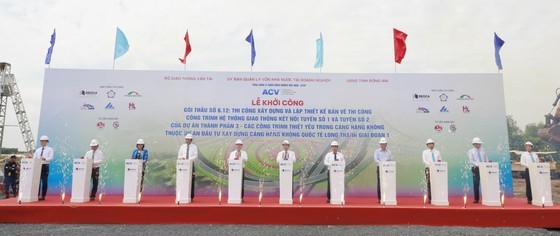
Once all stages are completed, it is anticipated that the Long Thanh International Airport will have a capacity of up to 100 million passengers per year, making it the largest airport in Vietnam in the future.
Once all stages are completed, it is anticipated that the Long Thanh International Airport will have a capacity of up to 100 million passengers per year, making it the largest airport in Vietnam in the future.
On the morning of July 14, the Airports Corporation of Vietnam (ACV), the project's investor, conducted the groundbreaking ceremony for package 6.12 for connecting road No.1 and No.2 of component project No.3 under the Long Thanh International Airport Construction Investment Project.
 |
| At the groundbreaking ceremony |
According to the plan, connecting road No.1 will be 4.3km in length and connect National Highway 51 to the Long Thanh International Airport with a speed limit of 80km/h. The connecting road No.2 will be 3.5km long and will link the Ho Chi Minh City-Long Thanh-Dau Giay Expressway to connecting road No.1, with a speed limit of 100km/h.
Along the entire route, there will be a total of nine bridges spanning a distance of over 3.8km, as well as three grade-separated intersections. These intersections will include the junction between connecting road No.1 and National Highway 51, the junction between connecting road No.1 and connecting road No.2, and the junction between connecting road No.2 and the HCMC-Long Thanh-Dau Giay Expressway.
The construction project is planned to have a duration of 885 days, with the goal of being completed in 2025.
Mr. Khuong Van Cuong, General Director of Deo Ca Group, said that the consortium of contractors had already prepared an adequate workforce, machinery, equipment, and essential materials to commence the construction package immediately after the groundbreaking ceremony. However, only about 70 percent of the land for connecting road No.1 has been handed over, while there is still no available land for connecting road No.2. The estimated material requirements for constructing both routes are approximately 1 million cubic meters of soil, around 10,000 cubic meters of sand, and approximately 214,000 cubic meters of stones.
Mr. Khuong Van Cuong recommends that the investor carefully assess the factors impacting the project schedule in order to find supportive solutions or adjust the contract timeline to better align with the current circumstances. Additionally, he suggests that Dong Nai province promptly provide adequate land, creating favorable conditions for the contractors to access the construction site, material sources, and waste disposal areas. It is essential to ensure safety and order in the construction area.
In his speech at the ceremony, Mr. Lai Xuan Thanh, Chairman of the Board of Directors of ACV, emphasized the high importance of the Construction Investment Project of Phase 1 for Long Thanh International Airport as a national project that holds great significance for Vietnam's socioeconomic development. The project entails the construction of one runway, one passenger terminal, and associated auxiliary components, all designed to accommodate a capacity of 25 million passengers and handle 1.2 million tons of cargo annually.
Upon completion of all phases, Long Thanh International Airport is projected to have a capacity of up to 100 million passengers per year, positioning it as the largest airport in Vietnam. Consequently, it is crucial to invest in constructing a transportation system that connects Long Thanh International Airport with the regional transportation network. This investment is essential to ensure seamless passenger accessibility and the efficient operation of the airport once it is operational.





